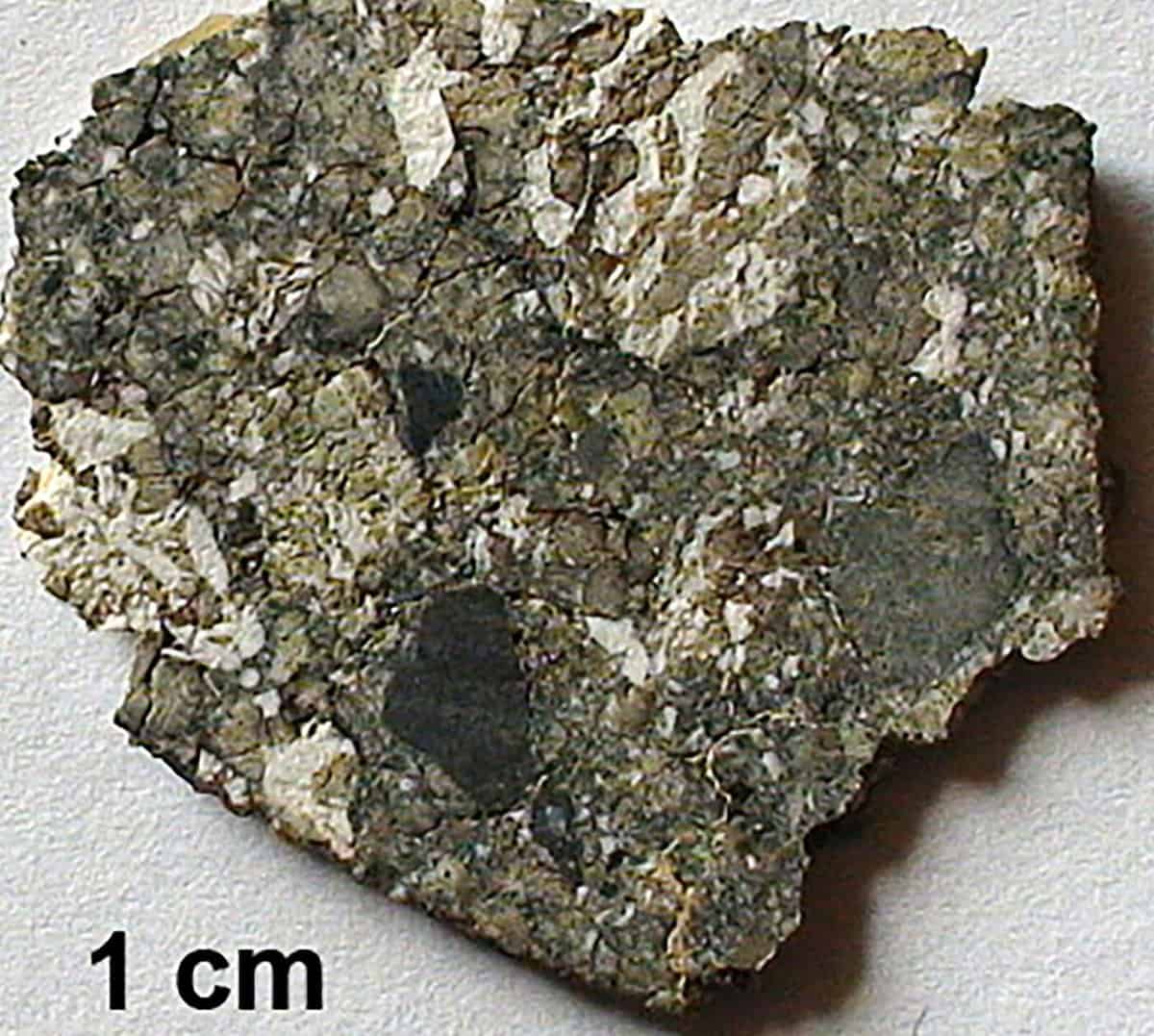In our previous discussion, we explored the fascinating journey of lunar meteorites from the Moon to Earth. Today, we will delve into the topic of lunar meteorite discoveries and the challenges inherent in identifying their origin.
Challenges in Determining the Source Crater of Lunar Meteorites
What is the number of lunar meteorites on Earth?
The combined weight of all identified lunar meteorites is a mere 58 kilograms. In contrast, the stone meteorites Allende and Jilin weigh 2 and 4 tons respectively, while certain iron meteorites surpass 10 tons in weight! (For instance, the Goba meteorite, Gavaone, Campo del Cielo). No lunar meteorites have been discovered in North America, South America, or Europe thus far. It is reasonable to assume that lunar meteorites have been descending onto these continents for the past 100,000 years, and if they have been found, they have not yet been recognized as lunar meteorites.
The majority of lunar meteorites have been discovered in areas that are widely recognized as prime locations for meteorite finding. These areas are typically arid deserts, where there are geological processes that lead to the concentration of meteorites and where terrestrial rocks are scarce. Additionally, these locations offer protection from the corrosive effects of water and Earth’s humid atmosphere, making them ideal for preserving meteorites.
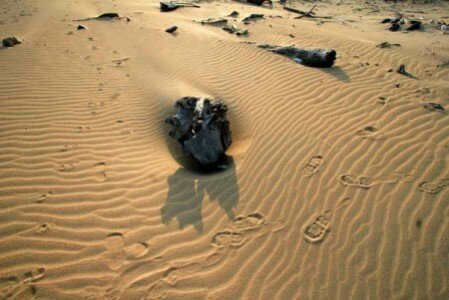
When searching for a lunar meteorite, the desert or Antarctica are the most convenient places to look for one.
A significant number of lunar meteorites have been discovered in Antarctica through expeditions supported by the U.S. government (ANSMET) or Japan (NIPR). In addition, a few lunar meteorites have also been found in the Sahara Desert located in North Africa. However, it is noteworthy that approximately half of all lunar meteorites have been found in Oman, and this discovery trend started in 1999. Interestingly, the majority of meteorites found in hot deserts are typically only found in private collections or obtained from local individuals.
The Challenges of Identifying Lunar Meteorites
New findings indicate that certain lunar rocks bear a striking resemblance to rocks found on Earth. However, it is a known fact that lunar meteoroids have been landing on Earth’s surface for millions of years. According to Mikhail Nazarov and his team at the Vernadsky Institute, an estimated “few tens or a few hundred kilograms” of lunar rocks, weighing between 10-1000 g, plummet to Earth each year. Despite this knowledge, the process of identifying and distinguishing lunar meteorites remains arduous.
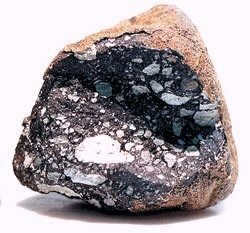
Under optimal conditions, such as in Antarctica, certain lunar meteorites can be easily identified as lunites due to their distinctive vesicular fusion crust. This is the coarse, bubbled surface found on meteorites like QUE 93069 or PCA02007. Unlike Earth rocks and other types of meteorites, lunar meteorites possess this unique crust. Although some lunar meteorites, specifically basalts, may not have a vesicular crust, the fusion crust of those found in hot deserts can be smoothed by wind. In the absence of a distinct fusion crust, it becomes more difficult to recognize a lunar (or Martian) meteorite as it closely resembles terrestrial rocks in terms of mineralogy and density.
Lunar meteorites are fragments of the Moon that have landed on Earth’s surface. These fragments are the result of impacts from asteroids, meteoroids, or comets colliding with the Moon. Such collisions occur on a daily basis, as meteoroids crash into the Moon. The Moon’s escape velocity is approximately 2.38 km/s, which is only a few times greater than the initial velocity of a bullet fired from a rifle (0.7-1.0 km/s). Consequently, any rock on the Moon’s surface that receives enough energy from a meteoroid impact can overcome the Moon’s gravitational pull and be propelled into outer space.
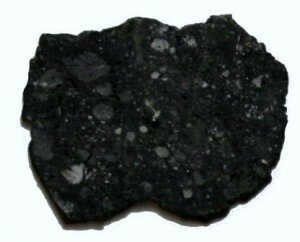
The Dhofar lunar meteorite originates from the Daedalus crater.
The majority of rocks expelled from the Moon are ensnared by the gravitational pull of either the Earth or the Sun and will enter into orbit around these celestial bodies. Over a span of time, ranging from a few years to tens of thousands of years, the meteoroids that encircle the Earth eventually descend to our planet. The fragments of the Moon that revolve around the Sun may also, eventually, descend to Earth, but this occurs after a time period of several tens of millions of years subsequent to their expulsion from the Moon.
The chemical composition, isotope ratios, and textures of lunar meteorites closely resemble those of lunar rock samples collected by American astronauts during the Apollo missions. These distinct characteristics set them apart from terrestrial rocks and other meteorite types. Lunar meteorites exhibit elevated levels of aluminum and calcium, which can be attributed to the unique formation of the moon. The moon’s local highlands primarily consist of anorthite, a mineral that is rarely found in asteroids or any other planet or its satellites.
Identifying lunar meteorites
When determining whether meteorites are paired or not, the number of meteoroids involved is taken into consideration, which currently stands at around 70. In most cases, these rocks are discovered in close proximity to each other as meteoroids tend to fragment upon entering the dense layers of Earth’s atmosphere, upon impact with the ground or ice, or while traversing through the Antarctic ice column (the origin of lunar meteorites from North Africa remains unknown).
The six lunar meteorites from the Lapaz Icefield exhibit fusion crust and rounded ribs that do not match each other. This suggests that the LAP meteoroid likely disintegrated in the atmosphere. Among the numerous lunar meteorites found in Dhofar, approximately 15 of them are believed to originate from the Daedalus crater on the Moon. The Daedalus crater, which has a diameter of roughly 93 kilometers, was photographed by the Apollo 11 crew in 1969.
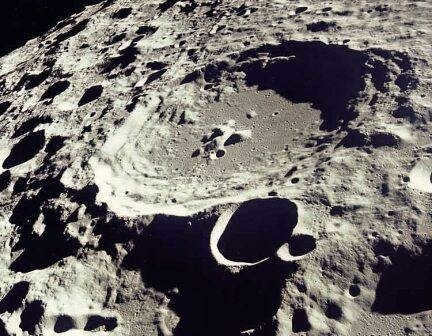
Reactions of a nuclear nature in meteorites from the Moon
Considering various pieces of evidence, it can be put forward that lunar meteorites have their origins in diverse locations. Additionally, it becomes plausible to determine the period of time during which these meteorites were subjected to the influence of solar wind (cosmic rays). The layers on the Moon’s surface, as well as the lunar meteoroids orbiting the Sun or Earth, become exposed to cosmic rays. These cosmic rays possess such high energy levels that they bring about nuclear reactions within the meteoroids, resulting in the conversion of one nuclide (isotope) into another.
Origins of lunar meteorites
The sources of lunar meteorites can be determined by analyzing the different radionuclides present in these meteoroids. Each radionuclide has its own unique half-life, allowing scientists to calculate various factors such as the duration of the meteoroid’s time near the Moon’s surface, the length of its journey to Earth, and the time of its fall. By studying the distribution of lunar craters, which are formed by the Moon colliding with asteroids or comets, researchers have gained insight into the likelihood of such collisions.
In 1994, Paul Warren presented compelling evidence suggesting that lunar meteorites originate from relatively small craters with diameters of just a few kilometers. His argument was based on the observation that all lunar meteorites that have been “launched” from the Moon within the past approximately 20 million years (especially within the last few hundred thousand years) can be traced back to these smaller craters. This suggests that there were no significant impacts involving large asteroids or comets during this time period…
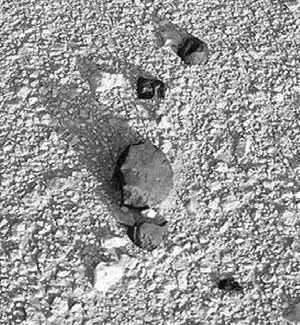
One of the primary sources of information regarding the composition of cosmic matter in the solar system comes from meteorites. These meteorites include rare specimens that have originated from the Moon and Mars. This article will delve into how these meteorites were discovered, how to identify them, and much more.
Firstly, let us review a few fundamental concepts. Meteorites can be categorized into three types: iron, ironstone, and stone. Stone meteorites are primarily composed of silicates such as olivine and pyroxene. Within this category, there are two subtypes: chondrites and achondrites. Chondrites derive their name from the fact that the majority of them (with a few exceptions) contain chondrules. Chondrules are spherical formations with a diameter of less than a millimeter, predominantly composed of silicates. They are formed through brief localized heating of gas and dust within the nebula. Meteorites belonging to this subclass were created within the protoplanetary cloud.
Distinctive examples include meteorites from the moon and Mars. The ones from Mars are also known as SNC meteorites, named after the Shergotty, Nakhla, and Chassigny meteorites. These meteorites have given rise to the subgroups known as Shergottites, Nakhla, and Chassignyites, each with their own unique rock types and compositions.
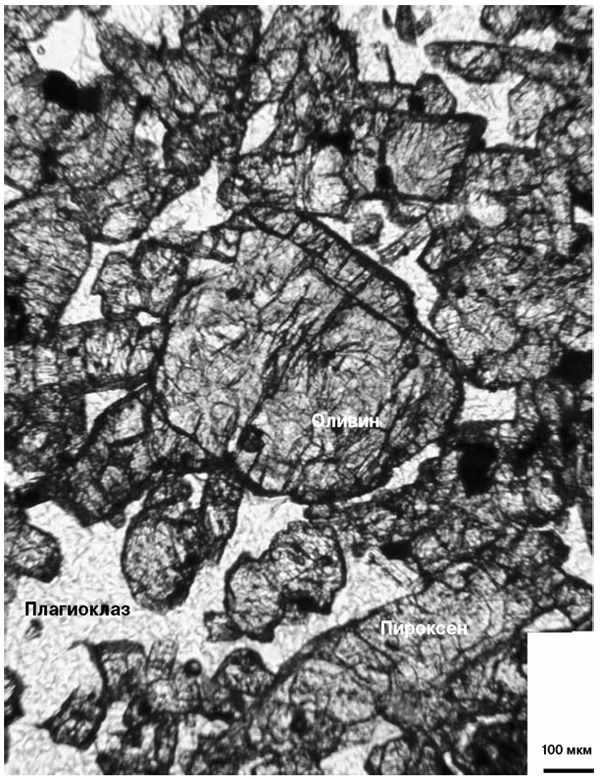
A brief look into the past
The occurrence of meteorite rock falls can be traced back to as early as the 7th century BC, and they have been mentioned in various sources such as the Bible, Chinese manuscripts, as well as the works of Livy and Plutarch. In the Russian chronicles, the first recorded instance of a meteorite fall was in 1091, described as follows: “A gigantic serpent descended from the heavens, causing great fear among all men. Simultaneously, the ground trembled, a sensation that many experienced.” (Laurentian Chronicle).
During the initial stages of scientific meteoritics, there was a prevalent belief that all meteorites (which were then referred to as aerolites) originated from the Moon. This hypothesis was later supported by mathematical evidence and gained widespread attention. Consequently, during that time, newspapers would publish predictions about the impending descent of lunar rocks, and there was even a market for moon rocks in Paris. However, subsequent research in the following years revealed that the majority of meteorites actually come to Earth from the asteroid belt. As a result, the notion of meteorites originating from the Moon was largely forgotten for an extended period of time. At that time, the concept of Martian meteorites had not even been considered.
The most suitable candidate for this position was Mars – its size is sufficiently large and it possesses a thin atmosphere, which allows for the ejection of material from the surface into space without hindrance, unlike the atmosphere of Venus. Additionally, it could be inferred that Mars, given its size, contains enough radioactive heat-generating elements to sustain prolonged geological activity. This hypothesis was further supported by the findings of scientists Donald Bogard and Pratt Johnson in their 1983 study of gas bubbles in certain shergottites, which are SNC-meteorites believed to be of Martian origin. The study revealed that the noble gas contents and isotopic composition of these meteorites matched those of the Martian atmosphere analyzed by the Viking spacecraft. To date, around 70 Martian meteorites have been discovered, some of which may be fragments from the same meteor shower.
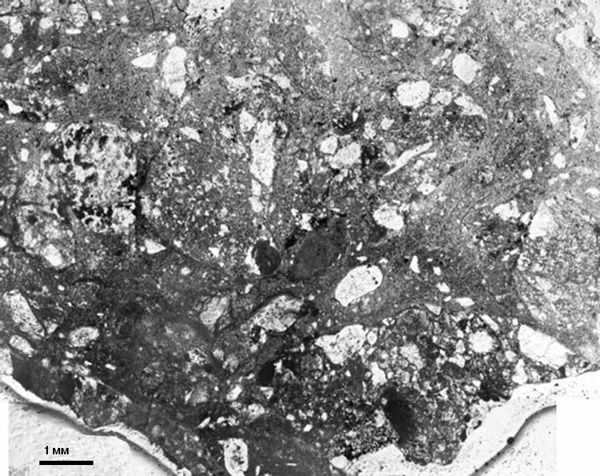
Figure 3. A section of the lunar meteorite Dhofar 311 (seen in transmitted light). This is a typical example of a lunar continental breccia, with fragments of rocks and minerals embedded in a glassy matrix formed by impact and fusion.
Most meteorites found on land or in mixed environments are breccias, which are rocks made up of fragments of other rocks and minerals held together by a glass-like material formed through impacts and melting. Among marine meteorites, there are both ordinary basalts and basaltic breccias. These breccias form due to ongoing meteorite bombardment, although it is on a smaller scale compared to the continental areas. The regolith formed in the oceanic regions has less thickness and strength compared to that found in continental regions.
All meteorites from the Shergottite-Nakhlite-Chassignite (SNC) group are made up of igneous rocks with a basic and ultrabasic composition. The main minerals found in these rocks are pyroxene, olivine, and plagioclase. These rocks formed as basaltic magmas crystallized. It is interesting to note that, despite the numerous impact craters on Mars’ surface, only one of the 70 known Martian meteorites, NWA 7034, is an impact breccia. However, all SNC meteorites show signs of impact. Additionally, there are no known samples of sedimentary rocks from Mars like the ones discovered by the Opportunity and Curiosity rovers. This could be due to the limited representation of Martian meteorites or the low durability of such rocks. Furthermore, there is a high risk of confusing Martian sedimentary rocks with terrestrial ones. Regardless, new discoveries of Martian meteorites have the potential to bring unexpected findings.
Where did it originate from? From the lunar sphere? Mars? Or from another celestial body?
If the meteorite is fragmented, contains over 50% plagioclase, and the plagioclase is calcic (anorthite), it is most likely a lunar continental meteorite, which can be verified by additional criteria. If the plagioclase is less than 50%, there are alternative possibilities: it could be a lunar marine meteorite, or a Martian meteorite, or a meteorite from the Howardite, Eucrite, Diogenite (HED) group, which is believed to originate from the asteroid Vesta.
Another distinguishing characteristic of lunar and Martian meteorites is the Fe/Mn ratio in the major rock-forming minerals olivine and pyroxene. In lunar rocks, it is approximately 89 in olivines and 54 in pyroxenes. In Martian rocks, respectively, it is around 43 and 30.
Regrettably, numerous discoveries in the desert exhibit comparable secondary mineralization, specifically carbonates and clay minerals, which originate from Earth. Consequently, distinguishing between these findings requires extensive and time-consuming investigations. However, there is a fortunate aspect to this situation. Certain Martian meteorites, including Chassigny, Shergotty, Nakhla, Tissint, and Zagami, are pristine falls that were promptly collected upon landing. Additionally, Antarctic discoveries do not possess any indications of terrestrial exposure. On the other hand, the circumstances surrounding the falls of lunar meteorites have never been witnessed. Astonishingly, all 180 lunar meteorites are findings, meaning that no one has observed their descent.
Lastly, naturally, conducting thorough research utilizing cutting-edge technology is necessary to ascertain these parameters. However, a skilled professional often only needs to examine the specimen under a microscope to identify the origin of a meteorite.
Locations for exploration and discovery
What is the cause behind the abundance of resources in Antarctica? Primarily, the white surface makes dark meteorites highly visible, while the cold and dry climate preserves them well. Furthermore, in certain areas, meteorites can become concentrated. As they fall to the surface, they gradually become buried beneath a thick layer of snow and ice. When a glacier starts moving towards a warmer region at the edge of the continent and encounters an obstacle that hinders its progress, such as a mountain range, the ice sublimates upon stopping, leaving meteorites on the glacier’s surface that can be gathered.
The meteorites derive their names from the locations where they are discovered. For instance, meteorites known as Yamato were gathered in Antarctica close to the mountain range bearing the same name, while the meteorites named NWA (North West Africa) were found in the Western Sahara region. Unfortunately, the majority of meteorites found in Antarctica and deserts lack precise coordinates indicating the exact location of their discovery, which is unfortunate. This is because many meteorites fall as meteor showers, making it challenging to determine their pairing (i.e., their affiliation with a specific meteor shower).
Other topics to explore in the realm of meteorites:
Check out the GEOHI RAS Laboratory of Meteoritics website for a wealth of valuable information, including guidelines for individuals who have discovered or witnessed the fall of a meteorite.
Also, don’t miss the chance to learn about lunar meteorites and Martian meteorites.

The theory known as the giant impact theory posits that the Moon came into existence as a complete satellite after a collision between the Earth and another large celestial body. Essentially, our planet and the Moon were once a single entity. Nevertheless, up until recently, there has been a lack of evidence supporting this theory. It is only now that scientists have discovered the initial evidence of this relationship through the examination of meteorites in Antarctica.
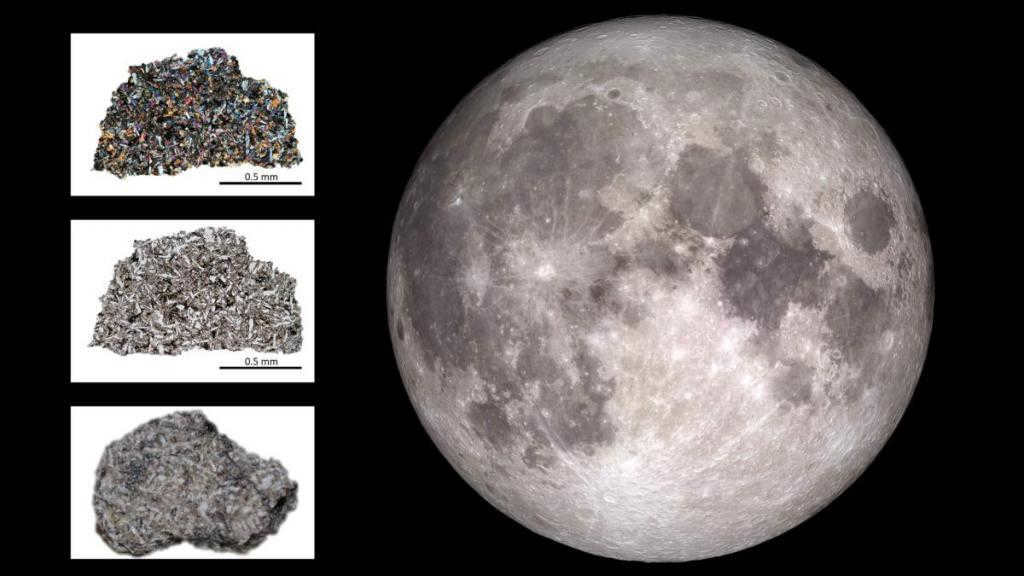
Researchers at the ETH Zurich Institute of Technology in Switzerland have discovered evidence of helium and neon in six meteorites from NASA’s collection in Antarctica.
These meteorites are composed of volcanic rock, specifically basalt, which was once molten magma that flowed onto the Moon’s surface from its interior. As the magma cooled, it formed lunar glass particles that trapped gases from the Sun, such as helium and neon. Over time, additional layers of space particles accumulated on top of the basalt, preserving it in its original state for scientists to study. Using a sensitive mass spectrometer, the researchers were able to detect traces of these gases.
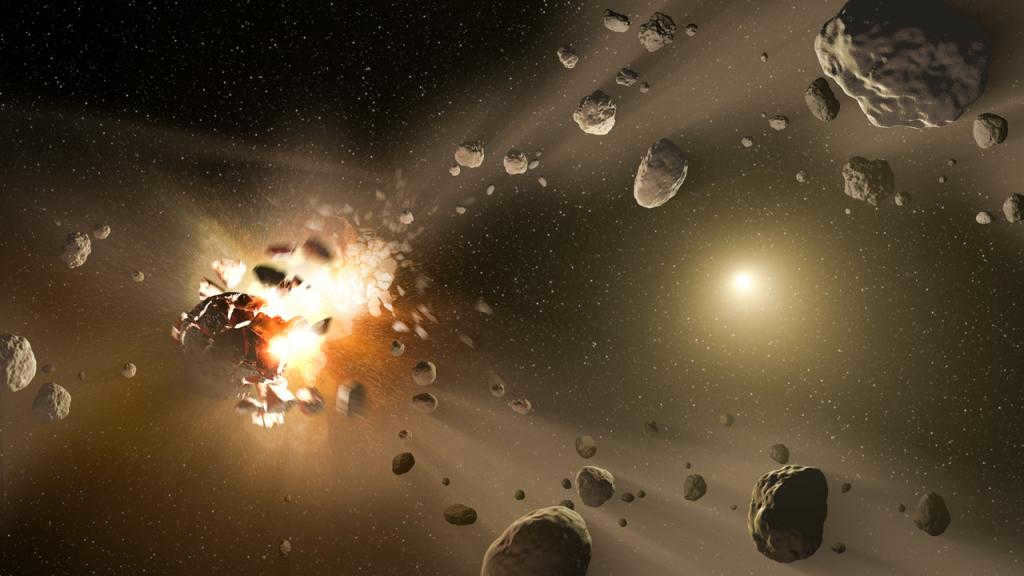
First and foremost, the findings of Swiss researchers provide further evidence supporting the hypothesis of a colossal collision that led to the creation of the Moon. As per one hypothesis, our planet collided with a protoplanet named Teia approximately 4.5 billion years in the past. The impact was incredibly forceful, causing materials from Earth’s core to be expelled into orbit instead of plummeting back down.
According to the prevailing theory, the Moon is thought to have experienced a collision with an asteroid. As a result of this impact, basalt samples were launched onto the lunar surface and eventually propelled into outer space. Eventually, these fragments found their way to Earth in the form of meteorites.
Currently, scientists are limited to studying meteorites that are part of NASA’s collection.

The study presents new possibilities for researching the formation processes of rocky structures within the entirety of the Solar System.
Simultaneously, researchers will be tasked with examining the heavy noble gases, along with their isotopes, found within meteoritic materials. The exploration for additional noble gases, such as krypton and xenon, will commence in the near future. Identifying these gases proves more challenging compared to helium and neon. While the presence of such gases doesn’t indicate the potential for life on the Moon, scientists are intrigued by how they managed to endure throughout the satellite’s formation.
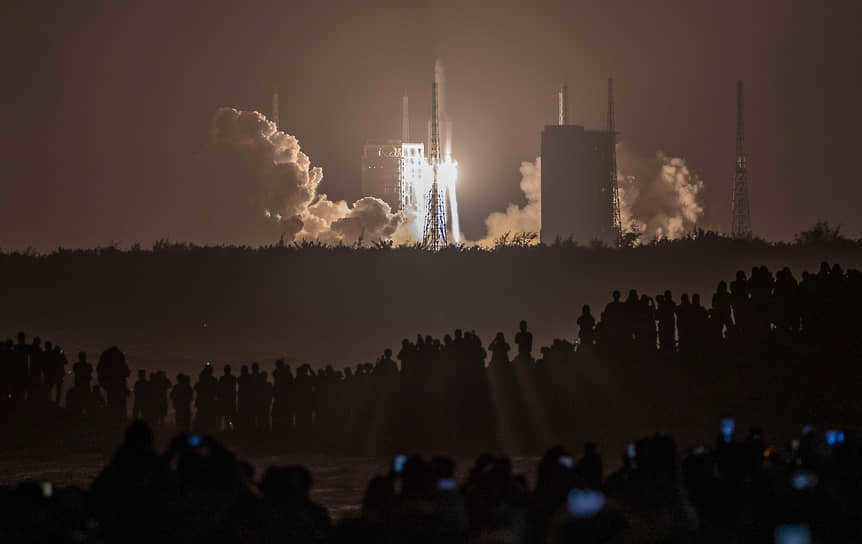
Go to full screen
The Chinese Chang’e-5 probe’s departure to the Moon from the Wenchang Cosmodrome was a significant event. On December 1, the probe successfully touched down on the lunar surface.
Yuri Etingof and Elena Kudryavtseva discussed the mission with Svetlana Ivanovna.
– Svetlana Ivanovna, what are the expectations of scientists regarding the latest batch of lunar soil brought back to Earth by the mission named after the Chinese Moon Goddess?

Click here to view in full screen
Svetlana Demidova, V. I. Vernadsky GEOCHI RAS
The significance lies in the fact that the Moon is an incredibly ancient entity that experienced an early preservation, contrasting with the Earth, where volcanic activity ceased long ago. By analyzing the Moon, we can gather invaluable insights into the development of celestial bodies, including our own planet, during its nascent stages when it remained unaffected by either an atmosphere or a hydrosphere. This is an immensely captivating subject, which explains the deliberate choice of this precise location by the Chinese for sample collection.
– From where were the samples obtained prior to this expedition?
In other words, Chang’e-5 successfully acquired a sample from the Moon’s visible side, but it was collected from a location that had not been explored before.
So, if this specific area is indeed intriguing, why is the Russian lunar program concentrating their efforts on the Moon’s poles? Could it be due to the potential presence of water?
– What insights can we gain from analyzing a sample?
– Besides understanding its composition, we can also gain insights into its formation and its historical events. Due to the lack of atmosphere on the Moon, it has a fascinating impact history, which refers to the formation of the celestial body through bombardment by asteroids, meteorites, and comets.
– How is lunar soil delivery conducted in present-day circumstances? What precautions are taken during the process?
However, the question remains: how can we effectively engage with these lunar samples?
Exploring the Moon: A Journey of Earthlings
The initial examination of lunar samples was conducted within a controlled nitrogen atmosphere, necessitating the creation of a specialized chamber. Presently, when soil samples are retrieved for analysis, they are swiftly shielded from Earth’s atmosphere to preserve their integrity. This cautious approach is also applied to lunar soil. Investigations into individual rock fragments are conducted using conventional methods, similar to those employed for terrestrial rocks, within standard laboratory settings.
– Evidently, the highest quality portion of regolith is being referred to. American astronauts collected sizable chunks of rocks individually, but for the most part, the lunar samples that have been brought to Earth consist of lunar regolith, which is the upper layer of loose material. It is incredibly fine and crumbly, with occasional specks of larger particles. In fact, one could even argue that all regolith appears to be dust-like. It is impossible to discern an individual particle with the naked eye, with a few exceptions. The hazard of this dust lies in the abundance of glass and its fragments resulting from impact processes. In other words, the dust particles are tiny sharp fragments, making them pervasive and highly detrimental to spacecraft.
– Is the Chinese mining also involving regolith?
– Does Chang’e-5’s soil collection compare to the current collections on Earth?
– The plan was to bring back approximately 2 kilograms of samples to Earth. In comparison, the Soviet Lunars only brought back about 300 grams. Our Institute of Geochemistry and Analytical Chemistry of the Russian Academy of Sciences has stored half of these samples in sealed metal containers for future generations. This decision was made back in the 1970s when the regolith was first delivered to the USSR. The remaining half of the samples was divided for research purposes and shared with other countries.
– How long will the samples be stored “for posterity”?
– NASA allocated nearly one million dollars last year to research the lunar soil. What is the reason for this now?
– I believe it is primarily about examining the preserved portion, and it is likely that the interest is related to the quest for water on the Moon.
– Is there currently an exchange of lunar soil samples between countries? Could there be a preliminary agreement with China already?
– Certainly, there is scientific exchange happening, and we still receive requests from various countries. These requests are reviewed by a special committee, which determines the amount that can be allocated. The decision is based on the feasibility and scientific significance of the research. As for China, they will probably first distribute the material among their own laboratories. Cooperation in the future is possible, although no agreements have been made yet.
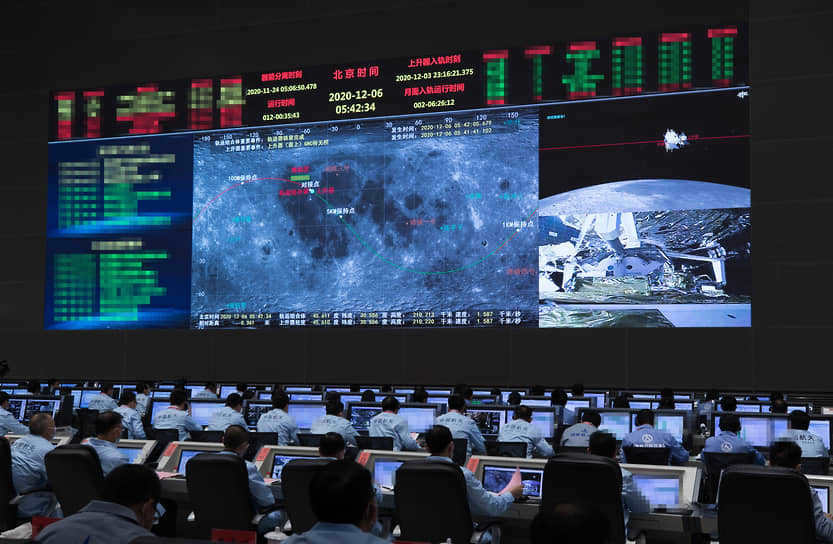
Click to enlarge
The Beijing Aerospace Center monitors the connection of a spacecraft that collected samples of lunar soil using a return module in lunar orbit.
– What is the reason for the abundance of rumors and myths about lunar soil and the credibility of the samples collected by the United States?
– It is widely known that during his visit to the United States in 1973, Lev Tarasov, an employee of GEOHI, was given lunar soil samples by the Americans, including sample 14321 – fragments of a large rock brought back by the Apollo-14 expedition. Have you had the opportunity to examine these samples?
– We have two slides of those samples. I conducted a study on them a couple of years ago, specifically searching for olivine fragments (a rock-forming material referred to as “O”) containing phosphorus. We did find it there, and the results of this research were published. Additionally, the American lunar soil is commonly referred to as Apollo-14 soil, and this particular sample has been extensively studied.
– Can you identify any significant differences between the American soil and the soil collected by the “moons”?
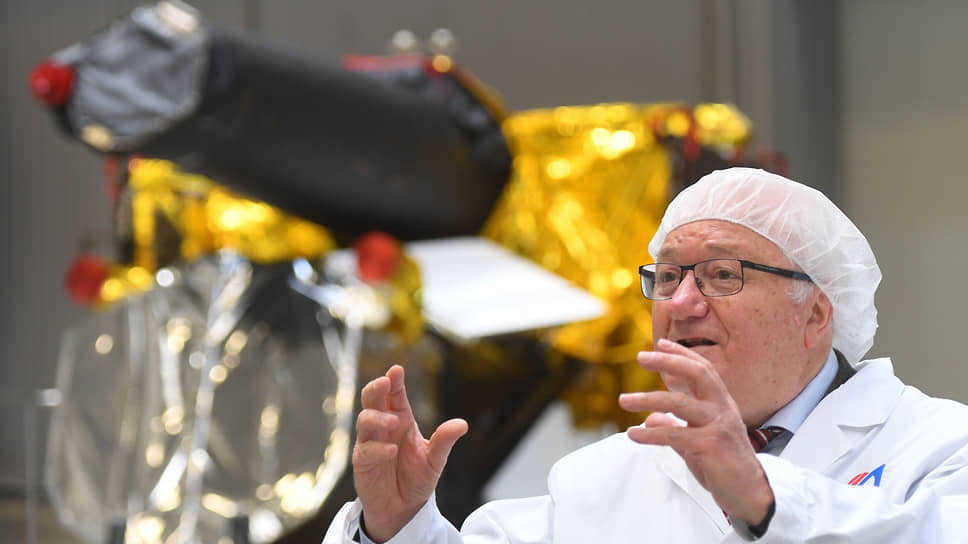
Astrophysicist Rashid Syunyaev discusses the new era of visualizing the Universe’s structure
– The basic classification features remain unchanged, with no significant differences observed.
– Critics claim that there is a lack of clarity on American soil, as neither Soviet nor Russian scientists have conducted certain studies, such as X-ray research and the analysis of magmatic samples. Is this statement accurate?
Speaking of Soviet scientists, it can be stated that the level of scientific curiosity in regards to the soil diminished over time, and there was a lack of new research from the early 1980s to the 1990s. However, a renewed wave of interest emerged when they stumbled upon lunar meteorites – meteorites that were expelled from the lunar surface and collided with Earth. Subsequently, after a prolonged break, research activities were resumed.
– The revival of interest in the Moon was attributed to the discovery of lunar meteorites. How many of them have been found to date?
– Quite a lot – likely over 300 kilograms. The Russian collection currently holds about 30 pieces of lunar meteorites.
What’s fascinating is that the identification of the initial meteorites was made possible through the analysis of data obtained from the examination of American and Russian soil. Simply examining a meteorite wouldn’t reveal its origin.
– What do lunar samples symbolize and is lunar material significantly distinct from material found on Earth?
– The majority of lunar meteorites are breccias – these are fragmented rocks that can easily be mistaken for many similar rocks found on Earth. However, there are specific locations where meteorites accumulate, making them relatively easy to locate, such as the ice of Antarctica or deserts. Researchers discover meteorites in these areas and subsequently analyze and classify them.
– Which of them are the most captivating?
– They are all captivating. For instance, in one meteorite, scientists have discovered a new mineral named hapkeite. Another astonishing find in meteorites is the presence of deep matter.
– The moon is home to massive craters. The impact of an incredibly powerful force can propel matter from the lower crust or even the mantle. On the Moon, there exists the largest crater in our solar system known as the South Pole-Eitken Basin. It has a diameter of approximately 2.5 thousand kilometers and a depth of 200-300 kilometers. The materials ejected from this crater are scattered across the moon’s surface due to numerous impact events, and occasionally, we can come across such remarkable samples from the moon’s depths right here on Earth. Thus, the study of lunar meteorites and lunar soil is an immensely significant and fascinating subject.
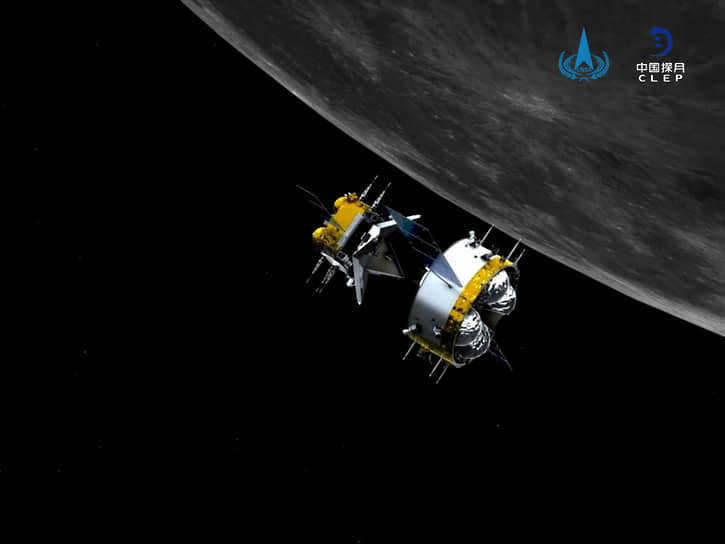
Click here to view in full screen
A computer-generated Chinese spacecraft is pictured in lunar orbit before its launch back to Earth.
– How actively is lunar soil studied in your institute currently?
– Lunar soil is studied consistently, although not as actively as in other countries due to a smaller staff. The latest findings include the discovery of olivine, a rock-forming mineral. Typically, olivine does not contain phosphorus, but we found olivine samples with phosphorus.
– Who is currently considered the global leader in lunar rock research?
– There are several scientists in the United States, Europe, China, and other countries. However, nowadays, international projects are typically collaborative efforts involving researchers from various nations.
– Can we conclude that there have been groundbreaking discoveries in your field recently?

What is the future of space exploration for Russia and humanity?
– One of the most significant achievements in space exploration is the discovery of water, which was made possible in part by the contribution of Russian scientists. The Russian Academy of Sciences’ Institute of Space Research developed the LAND instrument, which was installed on the American LRO satellite. This instrument played a crucial role in detecting the presence of water in certain craters located in the polar regions of the Moon. As a result of its findings, a comprehensive map showcasing the distribution of lunar ice in the polar regions was created.

